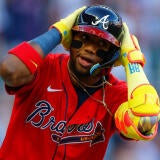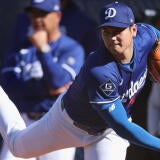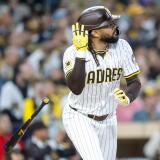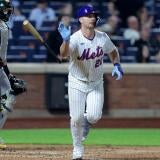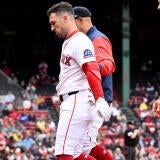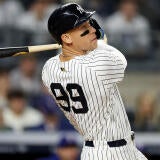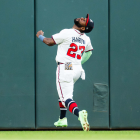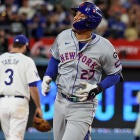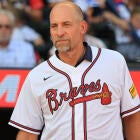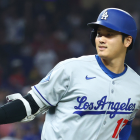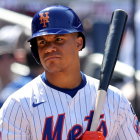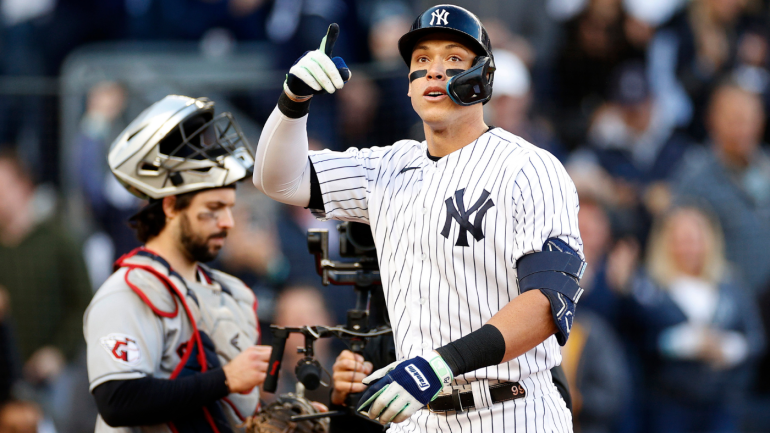
The end of the World Series means that it's time to focus on the future, and specifically the upcoming MLB free-agent class. The free agent market officially opened at 5 p.m. ET on Thursday evening, and players are free to negotiate the best deal for their labor.
As is the custom around these parts, CBS Sports has ranked the top 50 free agents in the class based on our evaluations and our predictions of what the market will look like. (Do note that some players may be added or removed once option decisions are finalized.) The rankings are formed from a combination of expected Annual Average Value and forecasted impact. Bear in mind this is more of an art than a science.
We've also included a few potential landing spots for each player. Please do not be the person who gets angry over those. They're for entertainment purposes only. Some teams are just more inherently likely to spend money, but we've ensured that every team gets mentioned at least three times (and no team more than five times) in the interest of avoiding repetition.
With that in mind, let's get to the hoopla.
1. Aaron Judge, OF
Here is the most menacing Judge this side of Cormac McCarthy's oeuvre. It may make no difference what men think of WAR, but Judge has amassed more of it during the Pandemic Era than any player except Shohei Ohtani, according to Baseball-Reference's calculations. How could he not have? He hits for average; he walks; he hits for power (obscure fact: he broke the American League's single-season home-run record); and he has one of the stronger outfield arms in the majors. The Yankees even used him in center for most of the season, a nod toward his athleticism.
AARON JUDGE HAS DONE IT!
— TSN (@TSN_Sports) October 5, 2022
NUMBER 62 TO BREAK THE AL ALL-TIME RECORD! pic.twitter.com/LMgkTCzVvx
The knocks against Judge remain the same as they were in the springtime, when he rejected a seven-year extension offer worth $213.5 million: 1) he's on the wrong side of 30 (he'll turn 31 in April) and 2) he's had his share of injuries. The most important number on Judge's stat sheet, then, might not be 62 but rather 152, or his average number of games played the last two years. Landing spots: Yankees, Giants, Dodgers.
2. Jacob deGrom, RHP
It reads oddly given deGrom's excellent track record, but he might be the biggest risk-reward proposition in the class. He's been one of the best pitchers in the sport since he debuted in 2014, of course, amassing two Cy Young Awards and four All-Star Games appearances along the way. There's no questioning his legacy, or his ability to throw a baseball with great efficacy when he's healthy -- therein lies the rub: how often will he be healthy heading forward? Injuries have limited deGrom to 26 starts over the last two seasons, and he's now a half-year shy of turning 35. Pitchers do not tend to stay healthier as they age. Seeing as how deGrom opted out of a one-year pact that would have paid him $32.5 million, it's likely that he's seeking a deal with an AAV closer to the $43 million Max Scherzer received last winter. Someone will undoubtedly pony up for a chance at adding a bonafide ace to their rotation, but they may end up experiencing buyer's remorse if deGrom's body continues to fail to comply. Landing spots: Mets, Rangers, Giants.
3. Carlos Correa, SS
In the past, we've referenced Bill James' theory that it's better for a player's perception if they start hot rather than finish hot -- that way, James once reasoned, their statline looks better for longer. Correa may be evidence of the theory at work. He started slowly, homering just once in April and producing a depressed statline that lingered into the summertime, leading people to believe he was having a down year even as he picked up his play over the course of the summer. Check his Baseball-Reference page now that the leaves are falling and you'll notice that his OPS+ was higher in 2022 than 2021, a season good enough to earn him the top spot in our free-agent rankings last winter. Correa remains a very good player, in other words, and it shouldn't surprise anyone if this time around he gets his rate and term. Landing spots: Dodgers, Cubs, Twins.
4. Trea Turner, SS
Turner has been the second-best hitting shortstop in the majors over the last three seasons, posting a higher OPS+ than everyone except Fernando Tatis Jr., whose production came in half as many plate appearances because of injury and suspension. He's a dynamic offensive player, an elite-grade runner with above-average raw power who is capable of posting a 20-20 effort each season. Turner does have an aggressive approach at the plate that sees him readily expand his zone, but it hasn't worked against him yet and, besides, mishit balls are an opportunity for him to leg out an infield single. The more concerning matter with Turner's game is his defense. He committed 16 errors last season, by far the most of the top free-agent shortstops. (Correa, Xander Bogaerts, and Dansby Swanson combined for 26.) Errors are an imperfect measure, though it's reasonable to think he may need to slide to the other side of the bag in the future (a position he's already familiar with, having played there out of deference to Corey Seager). Regardless, Turner has been a highly productive hitter throughout his career, and there's no reason to expect that to change soon. Landing spots: Cubs, Mariners, Orioles.
5. Xander Bogaerts, SS
Bogaerts is the Max Martin of shortstops, a consistent hitmaker with a sparkling trophy case. In each of the last five seasons, he's appeared in at least 84 percent of his team's games and has produced an OPS+ north of 125. He can hit for average, he can walk, and he's mostly hit for power. This season proved to be an exception on that last note, though a late May collision with Alex Verdugo that resulted in wrist and shoulder discomfort might be to blame. Defensively, Bogaerts has been a few years away from moving off shortstop for, oh, a decade now. Statcast data confirms that he still doesn't have top-end speed or arm strength relative to his peers. It's not easy to convince a big-league team you're playable at the six for this long unless you're doing something right. Even if Bogaerts is asked by his next employer to shift elsewhere, you have to give him credit for the hard work he put into improving his defense. Do note that Bogaerts opted out of his contract with three years and $60 million remaining, suggesting he's looking to improve on an AAV of $20 million. He should, easily. Landing spots: Red Sox, Twins, Giants.
6. Justin Verlander, RHP
Verlander had a most remarkable season. Remember back in the spring, when it was unclear how well or how much he'd pitch after missing most of the last two seasons because of Tommy John surgery? He put those concerns out to pasture in a hurry, starting 27 times and performing well enough to compete for a third career Cy Young Award. And he did this at a time when he's nearing his 40th birthday. Verlander has lived a charmed life in many respects, no doubt, but it's admirable that he's maintained this kind of work ethic and passion for the game despite having accomplished almost everything that a pitcher can accomplish.
Justin Verlander, Bowel Locking 80mph Curveball. 💩 pic.twitter.com/Kl1LydxAGM
— Rob Friedman (@PitchingNinja) November 4, 2022
He could've walked away and waited on his call from Cooperstown. That he instead put in the effort to come back this good is an impressive feat, and one that helps to explain the success he's had throughout his career. He declined a one-year option worth $25 million. He should net more money. Landing spots: Astros, Braves, Orioles.
7. Brandon Nimmo, CF
Juan Soto. Freddie Freeman. Bryce Harper. Aaron Judge. Paul Goldschmidt. What do those five players have in common? They're the only batters with at least 1,000 plate appearances during the Pandemic Era to reach base more frequently than Nimmo did. He's more than a pretty on-base: he's made improvements both as a center fielder and as a platoon-disadvantaged hitter, as the last two seasons have represented two of his three best single-season performances versus southpaws. If there is a stain on his T-shirt, it's his durability. Nimmo has appeared in more than 100 games just twice (thrice if you prorate his 2020 campaign over 162 games). The body doesn't tend to grow more durable as one ages, but Nimmo's top-of-the-order bat and middle-of-the-field glove should net him a lucrative long-term deal anyway. Landing spots: Mets, Tigers, Rockies.
8. Carlos Rodón, LHP
Rodón is a living testament to some of the game's recent philosophical shifts. Starters needing a reliable third pitch? Pff, that's the old religion. These days, Rodón chucks his fastball and slider more than 90 percent of the time combined and it isn't just allowed, it's encouraged. His mid-90s heater had the second-highest whiff rate (min. 1,000 thrown) in the majors last season behind Gerrit Cole, a byproduct of its velocity and rising movement, as well as the tough angle created by his release point. It's easy to think of Rodón's formula as being "elevated fastballs early, buried sliders late," but that's not the case. He's thrown his fastball more in two-strike counts than his slider the last two seasons, and it's reasonable to bet on him extending that streak. His injury history and lacking performance track record limited him to a short-term deal last winter. Rodón seems far more likely to get a long-term deal this offseason. Landing spots: Rangers, Giants, Cardinals.
9. Dansby Swanson, SS
Swanson has elevated his game during the Pandemic Era. In addition to launching 62 home runs since 2020, the third-most among everyday shortstops, he's hit for a roughly league-average or better OPS in each of the last three seasons. If there is an area of concern for him offensively, it's his swing-and-miss tendency. Swanson checked in 120th out of the 130 batters who qualified for a batting title in contact rate and the only shortstops to whiff more frequently last season were Javier Báez and Jorge Mateo, neither of whom had a particularly good offensive showing. To Swanson's credit, he has a better feel for the strike zone than either of them. He also continues to grade well defensively, particularly on balls that require him to move in or to his right. The risk here is that Swanson's strikeout rate will balloon as he ages and loses bat speed, but his power and defense should give him a solid base to work from. Landing spots: Braves, Mariners, Twins.
10. Clayton Kershaw, LHP
Kershaw is still good; still younger than his lengthy list of accomplishments suggests; and still seems more likely than not to return to the Dodgers on another one-year deal. Join us again next winter for another chapter of the same story. Landing spots: Dodgers.
11. Willson Contreras, C
The book on Contreras remains largely the same, but this winter may prompt the printing of a new afterword depending on his next contract. He's still one of the best hitting catchers in the business. He reaffirmed as much with a big season that saw him slice into his strikeout rate while launching 22 home runs in 113 games. Contreras is still backpick-obsessed behind the plate, too, as he gleefully threw behind runners 48 times last season, or more than the second- and third-place finishers combined. And yes, he's still a substandard framer, albeit better than he used to be. The last part is crucial since teams put a lot of weight in framing, and justifiably so. How many clubs will overlook Contreras' deficiencies in that area to add him to their lineup? And will anyone attempt to lure him to town by asking him to play a different position? You'd think "several" and "nope," in that order, based on an otherwise weak catching crop. Again, though, that's where the intrigue lies here, and we won't know for sure until we know for sure. Landing spots: Cubs, Angels, Cardinals.
12. Anthony Rizzo, 1B
We wrote last winter that Rizzo's strong ball-tracking data indicated he may have had one more big year left in him. A full season later, we can write with the utmost certainty that he did. Rizzo will now attempt to monetize his stellar campaign after declining his $16 million player option. He's a 33-year-old first baseman with back concerns, so there's probably a limit on how far teams are willing to go term- and dollar-wise. Still, is there any doubt that some team will give him a multi-year commitment with the hope that he can produce at least one sequel? We think not. Landing spots: Yankees, Orioles, Astros.
13. Chris Bassitt, RHP
Bassitt will turn 34 years old in February, suggesting he'll have to settle for a higher rate over a shorter term. Fair enough. He shouldered a career-high workload in his first season with the Mets, crossing the 160-inning threshold for the first time in the big leagues. When most people think about Bassitt, they think about the unusual mechanics that end with him dipping his glove low and away from his body. Not us. We're Students of the Game who instead think about all the potential dog puns offered by his surname. We also, ahem, think about his contact-management skills. Bassitt has good command over a deep arsenal that includes three fastball variants and a pair of breaking balls. Some pitchers are fortunate if they can spin the ball east and west, Bassitt can do that and put backspin on the ball, giving him a trove of looks. Landing spots: Mets, Yankees, Blue Jays.
14. Edwin Díaz, RHP
Only two pitchers in baseball's recorded history have thrown at least 20 innings in a season and struck out a higher share of batters than Díaz's 50.2 percent mark. Is it any wonder why his Baseball Savant page resembles an orchard, what with all the red bulbs hanging around? Díaz pairs a devastating slider with an upper-90s heater, an unfair combination on paper that becomes lethal in three dimensions thanks to the flatness and the depth of his release point (he gets down the mound and generates more than seven feet of extension from the rubber).
Edwin Díaz, 102mph Fastball and 91mph Slider, Overlay/Slow. 🎺
— Rob Friedman (@PitchingNinja) August 8, 2022
Díaz closing for deGrom isn’t very fair. pic.twitter.com/fHc59CCjE4
(Update: Since this list was originally published, the Mets and Díaz reportedly agreed to a five-year deal worth $102 million.)
15. Michael Brantley, OF
Brantley is and has been a terrific hitter for nearly the duration of his big-league career. He'll turn 36 in May, though, and he didn't play after June 26 because of a shoulder injury that required surgery. He's a prime candidate to sign a one-year deal with the Astros or another contender willing to bet that he makes a full recovery. Landing spots: Astros.
16. Jameson Taillon, RHP
Taillon is your broken-in pair of sneakers. He's not flashy, but he achieves the desired effect provided expectations are kept in check. Over the last two seasons, he's started 61 times and amassed a 100 ERA+ while averaging around 5.3 innings per pop. He has a wide arsenal, complete with three fastball variants, though he's just-OK at missing bats and barrels. You may think Taillon pounds the strike zone based on his walk rate. He doesn't. He throws a below-average amount of pitches within the zone, making up for it by generating slightly more chases than the average bear. Maybe Taillon isn't your old sneakers, maybe he's your second-favorite TV show as a kid. Watching him now, he's not as good as you remember, but you often walk away satisfied. Landing spots: Padres, Red Sox, Yankees.
17. José Abreu, 1B
Abreu is getting old (he'll turn 36 before spring training), but he keeps hitting. More than half of his batted balls last season had an exit velocity of 95 mph or higher; here's a complete list of qualified batters who fared better in that area: Aaron Judge, Yordan Alvarez, Kyle Schwarber, and Teoscar Hernández. His maximum exit velocity, meanwhile, was in line with the marks posted by the likes of Juan Soto and Lars Nootbaar. The market tends to be unkind to older right-right first basemen, but Abreu, whose bat contains more pop than The 1975's discography, may be an exception. Landing spots: Cubs, White Sox, Astros.
18. Andrew Benintendi, OF
Benintendi achieved his best statistical season in years by trading power for contact. That may sound overly simplistic, but sometimes the truth is like that. He set a new career high in both batting average and on-base percentage, and a new career low in slugging percentage. Benintendi's batted-ball profile did shift toward elevating the ball following a midseason trade to the Yankees, and, perhaps predictably, he recorded just seven fewer extra-base hits in pinstripes than he had with the Royals despite appearing in 60 fewer games. Benintendi's season ended prematurely when he fractured his hamate bone in September. He's not everyone's can of LaCroix, but he's a fine most-days corner outfielder, even if he's unlikely to bring the boom often. Landing spots: Mariners, Marlins, White Sox.
19. Kenley Jansen, RHP
As unusual as it was to see Jansen wearing a non-Dodgers uniform, he by and large produced another of what's become his standard post-prime season. For posterity's sake, we will note that Jansen, forever a master of suppressing quality contact, allowed his highest average exit velocity of the Statcast Era. That statistic can be blamed on batters posting a .525 slugging percentage against his sinker. Jansen's cutter, conversely, remained effective. We suspect that he will too for as long as that's true. Landing spots: Braves, Dodgers.
20. Andrew Heaney, LHP
Heaney picked up one of the Dodgers' specialties, a sweeping slider, and paired it with his highly efficient fastball en route to the best season of his career. He set new personal bests in ERA+ and strikeout-to-walk ratio, and he finished second among pitchers with 10-plus starts in whiff rate. It wasn't all guitar solos and drum fills: he allowed the highest percentage of batted balls with an exit velocity of 95 mph or greater, suggesting batters made good contact when they did connect. He also threw just 72 innings because of injuries and a short leash that saw him average fewer than 20 batters faced in his final 11 starts. It's fair to have reservations about buying all the way in on Heaney as a front-of-the-rotation starter. Still, we do think he should be at least league-average moving forward. Landing spots: Mets, Red Sox, Rockies.
21. Tyler Anderson, LHP
Anderson had his finest big-league season at age-32 after he reverted to an old changeup grip. While he's always excelled at suppressing quality contact, he took it a step further in 2022. Indeed, no pitcher with at least 10 starts last season posted a lower average exit velocity against (84.5 mph). Anderson's new/old changeup clocked in a tick slower and with about seven inches more drop. In turn, his changeup proved to be more wood-adverse than Green Lantern, with batters whiffing on 37 percent of their swings. Anderson also gained some extension on his pitches, including his trademark backspin fastball and a cutter that loves to locate to his glove side. (Sometimes he'll drop his arm slot, à la Rich Hill, to throw a sinker.) Even if Anderson regresses, he has a long history of being an average starter at the big-league level. Landing spots: Royals, Cardinals, Blue Jays.
22. Zach Eflin, RHP
Studies have found that individuals who endure near-death experiences often transform their lives in positive ways. Eflin's late-season move to the bullpen wasn't as traumatic as teetering between the corporal and ethereal realms, but you wonder if it'll nudge him in a better direction anyway. That doesn't necessarily have to lead to him becoming a full-time reliever; let's face it, there's still more money to be made in starting games, and teams have overlooked worse cases of durability problems. (He's thrown more than 130 innings in a big-league season just once.) It could mean, simply, that Eflin embraces the sinker-curve-cutter trio that led to his bullpen success rather than falling back on his old starter's arsenal. We'll see. Landing spots: Phillies, Padres, Diamondbacks.
23. Kodai Senga, RHP
Senga, 29, is expected to pursue a big-league contract this winter after spending the first 11 seasons of his career with the Fukuoka Softbank Hawks of Japan's Nippon Professional Baseball league. He's an accomplished right-hander who posted a 1.89 ERA and a 3.18 strikeout-to-walk ratio this season across 148 innings. Senga's best pitches are his lively mid-90s fastball and his devastating "ghost" forkball, a true out pitch in the majors or anywhere else.
Kodai Senga, 99mph Fastball and 84mph Slider, Individual Pitches + Overlay. pic.twitter.com/nF60sUBvED
— Rob Friedman (@PitchingNinja) November 2, 2022
He's capable of stair-stepping with that combination, raising the heat before burying the fork. (If he lands in Chicago, maybe his nickname should be The Bear?) He also throws a decent curveball. Landing spots: Cubs, Blue Jays, Rangers.
24. Jean Segura, 2B
In addition to being a good fielding second baseman, Segura has been a league-average or better hitter in six of his last seven seasons thanks to his feel for contact. He walks and bops just enough to keep him from having an empty line. Unfortunately, Segura is also a good bet to connect with the injured list: he's appeared in more than 150 games just once in his career, and he's missed 95 games combined the last two seasons. This may prove to be an overrank if his durability slides further. Landing spots: Phillies, White Sox.
25. Joc Pederson, OF
The Giants have mastered the art of salvaging careers. While most of their best work has come on the pitching side, Pederson is evidence that they can help hitters restore lost value, too. He's always hit the ball hard, but in 2022, he did so with greater frequency and at a more optimized angle after the Giants seemingly worked with him to clean up his swing path. Pederson isn't much of a defender anymore -- he may never play another inning in center field -- yet this time last year it looked like he would become a vagabond in the Reggie Sanders mold. Now, thanks to his excellent year by the bay, it's easier to envision him landing a multi-year contract. Landing spots: Giants, Yankees.
26. Christian Vázquez, C
Good catchers are difficult to find. Vázquez was too following the midseason trade that sent him to Houston. He started just 23 of the Astros' remaining 59 games, as manager Dusty Baker seemingly preferred Martín Maldonado's familiarity with the pitching staff. Don't hold that against Vázquez, who remains a skilled defender. He's an above-average receiver with a strong arm and one of the quickest transfers in the league. Vázquez has also finished with league-average offense (or thereabout) in three of the last four seasons, giving him two-way value. He turned 32 late in August, but he should still fetch a multi-year deal -- hopefully with a team that will play him. Landing spots: Rays, Guardians, Cardinals.
27. Kevin Kiermaier, OF
Where have all the center fielders gone? There weren't many out there at the trade deadline, and there aren't many available for hire in this free-agent class, either. Kiermaier appeared in only 63 games because of hip trouble that culminated in season-ending surgery, but he nevertheless qualifies as one of the top options. It's fair to wonder if and/or how the operation will impact his athleticism and explosiveness. We won't speculate on that because it's pointless. We will note that prior to the surgery, Kiermaier remained one of the top defensive outfielders in the majors thanks to a combination of his great speed, strong arm, and penchant for making GIF-worthy grabs. Kiermaier's bat is far more likely to be below-average than above, yet the lack of compelling alternatives means it's best to embrace what he gives you in the field and cherish any additional value he creates at bat. Landing spots: Dodgers, Red Sox, Marlins.
28. Jurickson Profar, LF
This isn't the career evaluators expected from Profar back when they projected him to become an All-Star shortstop, but it's a respectable way to make a living all the same. His bat still doesn't fit the corner-outfield archetype: he's more about walks and singles than home runs, and his ball-tracking data more closely resembles Jake Cronenworth's than it does Kyle Schwarber's. There's value in what Profar does, however, and fate may have led him to the open market at the perfect time. It's at least possible that the Cleveland Guardians' success with a lineup of similar hitters could inspire the copycats around the league to overindex on contact and walks, to the extent that Profar benefits with a little extra coin than he would've netted otherwise. Landing spots: Padres, Reds, Angels.
29. J.D. Martinez, DH
Martinez, 35 years old as of August, can still hit. Not as well as he once did, when he was the sport's premier designated hitter following David Ortiz's retirement, but well enough to envision him fetching a starting job on a contender.
Today's lead presented by J.D. Martinez! pic.twitter.com/3ElqGfMUNn
— Red Sox (@RedSox) September 29, 2022
At this age, and with this profile, you start to worry about bat speed decline. Rest easy here. Martinez ranked in the 80th percentile of batted balls hit 95 mph or harder on pitches that were 95 mph or faster. In English: he remains able to punish fastballs, even hot ones. Landing spots: Rangers, Marlins, Orioles.
30. Justin Turner, 3B
The other Turner in this class had his $16 million club option declined by the Dodgers just days shy of his 38th birthday. (At least the $2 million buyout made for a decent present?) Turner is an attrition risk in a few respects: 1) he's on the older side; and 2) he's played in 150 or more games just twice in his past eight regulation-length seasons. Nevertheless, he remains capable of getting on base and it's not like the third-base market is brimming with great options. Landing spots: Diamondbacks, Brewers, Rays.
31. Nathan Eovaldi, RHP
Eovaldi has been on a years-long quest to answer one question: how often does a starter have to throw his fastball, anyway? He opted for the old No. 1 less than 40 percent of the time last season, rolling instead with a healthy heaping of cutters, breaking balls, and splitters. That looks like a wise decision. Despite Eovaldi's mid-to-upper 90s velocity, his fastball was hammered to the tune of a .306 batting average, a .522 slugging percentage, and a 92.3 mph average exit velocity. Only a handful of pitchers with at least 20 starts in 2022 allowed a higher percentage of batted balls with exit velocities of at least 95 mph. That statistic doesn't necessarily spell doom; Tyler Glasnow and Framber Valdez allow a lot of hard contact, they just atone for it by either missing an extreme amount of bats or generating a ton of grounders. Eovaldi doesn't do either, which leaves him in a more vulnerable position. Hence his ranking lower than his recent ERA and strikeout-to-walk ratios merit. Landing spots: Rockies, Tigers, Angels, .
32. Michael Wacha, RHP
Wacha has become a back-of-the-rotation nomad, pitching for a different team in each of the past four seasons. He might make it five-for-five following his strongest effort since 2018. Wacha's arsenal remains centered around verticality, as you would expect based on his arm slot. For our money, the most interesting part about his season was his embrace of a "sinker." The quotation marks are necessary because this isn't your standard sinker that aims to disrupt worms and ant colonies alike. Wacha's ranked fifth in Induced Vertical Break, behind Kenley Jansen, Drew Smyly, Josh Hader, and Bailey Falter -- or, the Nos. 1, 2, 3, and 7 sinkers most prone to being hit in the air. Put another way, Wacha's sinker would have above-average "rise" for a four-seam fastball, meaning he's not going to turn into Framber Valdez or Logan Webb anytime soon. (It would be cool if he did though; scientists would get a kick out of it.) We won't go so far as to credit Wacha's weird sinker for his year (he threw it only 13 percent of the time) or suggest it'll change his career. We just think it's neat. Landing spots: Brewers, Blue Jays, Royals.
33. Ross Stripling, RHP
Stripling, plagued by the home-run ball throughout his career, may have figured out a solution to the problem in the form of his new changeup. For the first time in his career he deployed his cambio as his top secondary offering. His faith was rewarded as his change ended up leading his arsenal in batting average against and whiff rate. What's more is that Stripling's changeup ranked near the top of the majors in both swing and chase rates. That combination, plus the results the pitch generated, indicates batters had a hard time identifying it out of his hand. (His old changeup was said to be too recognizable because of the pitch's spin.) There's no guarantee Stripling will continue to suppress home runs to this extent, but a team betting on him achieving a new true talent level can take solace that he'll invest the money wisely. He might be the big-league player most likely to know the Black–Scholes equation. Landing spots: Diamondbacks, Royals, Angels.
34. Michael Conforto, OF
Conforto didn't play last season after suffering a shoulder injury during a workout. His disappointing walk year left him ranked in the 20s on our top 50 list last winter, and it seems only fair to drop him a bit further this year. That said, his track record should still enable him to land a big-league contract with an eye on being someone's starting corner outfielder. Landing spots: Rays, Blue Jays, Braves.
35. Josh Bell, 1B
It's always interesting when production and reputation diverge. Since the start of the 2019 season, Bell has a higher OPS+ than the following group of middle-of-the-order hitters: Anthony Rizzo, Kris Bryant, Austin Riley, Rhys Hoskins, Nate Lowe, and Max Muncy. So, why is it that he isn't viewed as a serious threat? Some of it is timing, as he had a dreadful run with the Padres; some of it is aesthetics, since neither of his swings inspire romantic notions about the kinetic chain; and some of it is approach, seeing as how he's a contact-heavy hitter whose at-bats served as glorified infield practice following the trade.
Bell rung. pic.twitter.com/AqtlKRIeep
— MLB (@MLB) October 8, 2022
A few teams, like the Rays, have done well acquiring players who hit the snot out of the ball, albeit right into the earth. It's not a profile that everyone values, though, especially not when it's attached to a lumbering first baseman who seems closer to DH-only duty than not. Of course, it only takes one team to look at Bell's track record and think, hmm, we can get him back to hitting 25-plus home runs a year. But we do think that, on the whole, that Bell might end up being paid less than his multi-year statline indicates he should. Landing spots: Astros, Rays, Guardians.
36. Trey Mancini, 1B
Mancini looked like a different hitter after being traded to the Astros at the deadline. He produced far worse results while embracing an altered approach and setup (he closed off his stance and stood more upright). Mancini became obsessed with pulling the ball. It didn't work out for him, but you can understand the temptation: yanking one into the Crawford Boxes after dealing with Walltimore had to feel as easy as pedaling around the block days after braving a hors-catégorie climb. Mancini's track record indicates he should regain form as an average or better hitter in 2023. His months-long spiel to end the season, in concert with his standing as a right-handed first baseman-slash-DH, may nonetheless result in a chilly reception this winter. Landing spots: Guardians, Mariners, Athletics.
37. Jace Peterson, 3B
Peterson took the scenic route to obtaining six years of service time. Not only did he suit up for five organizations, but he also found himself on the outs twice with Milwaukee, the closest thing he's had to a long-term home. (He was non-tendered in 2020 and then outrighted from the 40-player roster in 2021.) Peterson has been a roughly league-average hitter against righties during the Pandemic Era, with his wOBA against them checking in within a few points of those posted by the likes of Ozzie Albies, Matt Chapman, and Trevor Story. He's a good defender at the hot corner, too. (If you're having trouble differentiating between monsieurs Jace Peterson and Joc Pederson, just remember that the former's glove will make your pitcher look like a J-ace.) It's not a star profile by any means, and he needs to be paired with a righty bat in order to get the maximum value from him at the dish, but there are only so many players on the market who could start at third most days and be OK. Peterson is one. Landing spots: Tigers, Marlins, Rockies.
38. Rafael Montero, RHP
On July 27, 2021, Montero was shipped from Seattle to Houston as part of a four-player trade. He was sporting an airplane ERA in 40 appearances, and it was conceivable that he would be non-tendered in the winter. The Astros kept him around, and they have to be thankful they did: Montero has made 75 regular-season appearances since the trade, amassing a 2.18 ERA along the way. He throws four pitches, including a pair of mid-to-upper 90s fastballs, and none of them clock in slower than 87 mph. He's a power pitcher, in other words, who generates the necessary force to live in that velocity bracket by achieving an impressive amount of separation between his shoulders and his hips at foot strike. He also benefits from one of the flattest planes from his release point to the top of the zone in the majors. He's heading for a multi-year deal this winter, and rightly so. What a turnaround. Landing spots: Brewers, Phillies, Diamondbacks.
39. José Quintana, LHP
Quintana's one weird trick for resuscitating his career as a 33-year-old? Surrendering four fewer home runs than he did in 2021 despite throwing 102 additional innings. His game is and has always been based on contact management. He doesn't have loud stuff, but he locates what he has well enough to get by. And get by he has. Quintana has been a competent starter for roughly a decade now, save for the 73 combined innings he threw during the 2020-21 seasons. Because crafty left-handers are essentially interdimensional beings, unbound or ungoverned by the rules of linear time, Quintana should be a decent bet to have at least one more solid year. Landing spots: Tigers, Twins, Athletics.
40. Martín Pérez, LHP
Pérez returned to Texas with aplomb after three seasons spent elsewhere. He made his first All-Star Game and he finished with the best ERA+ of his career. You might suspect that Pérez made a huge overhaul to his game. He didn't. He threw his sinker as his primary pitch again for the first time since he left, and he dropped his cutter to third in his usage chain. Otherwise, he pitched to the edges of the zone and tried to induce fieldable ground balls. We don't want to take anything away from Pérez's homecoming, but we do have some reservations about him keeping up this level of production heading forward. He doesn't miss many bats and his strikeout-to-walk ratio over the final two months dipped to 1.82, below his career norm entering the year. Expecting him to pitch more like a No. 4 starter seems reasonable. Landing spots: Rangers, Padres, Angels.
41. Masataka Yoshida, OF
Yoshida, 29, is reportedly expected to be posted by the Orix Buffaloes before the Dec. 5 deadline. He's a two-time batting champion who hit .336/.449/.559 last season with 21 home runs. Yoshida's game is dependent on making a lot of contact, something he did to great effect in Nippon Professional Baseball. (He recorded 100-plus more walks than strikeouts in seven seasons.) He's a pure left fielder with just 21 career stolen bases to his name, and it's highly unlikely that his power translates in whole. There's value to be found in a singles-and-walks corner outfielder, but teams will likely prefer Andrew Benintendi and Jurickson Profar given their established track records. Landing spots: Giants, Red Sox.
42. Taijuan Walker, RHP
This may prove to be an underrank of Walker, who we expect will decline his $6 million player option and net a more lucrative deal on the open market. To his credit, he's appeared 70 times during the Pandemic Era, amassing a 105 ERA+ and a 2.76 strikeout-to-walk ratio.
Taijuan Walker, Filthy Splitters. ✌️ pic.twitter.com/LMLpKnnWpl
— Rob Friedman (@PitchingNinja) April 11, 2022
He's made several tweaks to his arsenal during that period, too, most recently reducing his fastball usage rate and upping his dependency on a splitter. To his debit, Walker still doesn't miss many bats, and he doesn't manage contact as well as you might expect. He's also been markedly worse in the second half of each of the past two seasons, becoming concerningly home-run prone this year. Landing spots: Rockies, Royals, Nationals.
43. Robert Suarez, RHP
Suarez, who had never pitched outside of Japan or Mexico prior to last season, took well and quickly to his new environment. He'll now seek a larger payday to reward his adaptability, having declined a player option worth $5 million. Suarez should get it, too. He has a power arsenal, including a pair of upper-90s fastballs that play up because of his deep and flat release point, but his best pitch might be his upper-80s changeup: batters hit .089 against it and whiffed on 40 percent of their swings. Suarez did have some issues with his command, but that shouldn't hold him back too much. Landing spots: Brewers, Phillies, Royals.
44. Nick Martinez, RHP
It would be cheating to write that Martinez looked different from when we last saw him (he spent four seasons in Japan, after all) but it's true. New team. New haircut. New number. New pitcher. He scrapped his over-the-head windup in favor of a Clevingerian rocker step, and shortened his arm action so that his hand arc barely dips below his beltline, not his midthigh. In one respect, though, he remained the same: an unclear role. Martinez started the season in the rotation and spent the rest of the year in the bullpen, becoming one of two pitchers to record five-plus starts and saves (Garrett Whitlock being the other). Martinez has a varied arsenal that is good enough to elicit chases and suppress quality contact, but not loud enough to rack up huge strikeout totals. (Even in relief, he averaged only eight K's per nine innings.) Of course, it takes just one team to view him as a starter for him to then be paid like a starter. Landing spots: Padres, Brewers, Cardinals.
45. Evan Longoria, 3B
Longoria is nearing the end of the line on what's been a terrific career. He's sporting a 119 OPS+ over the last two seasons, but don't be deceived by his marks: he's no longer an everyday player. Right-handers (specifically their sliders) tear him up, making him a liability to start most days. If Longoria is open to a part-time role, and it would be within his rights to opt instead for retirement, he should be able to provide offensive value versus left-handed pitchers. The Giants used him well in that respect, empowering him with the platoon advantage a career-high 44 percent of the time in 2022. Whatever the future holds, Longoria should be proud of his past. Landing spots: Diamondbacks, Rays, Brewers.
46. Wil Myers, OF
Think of Myers as the watered-down version of his former Padres teammate Hunter Renfroe. They're both right-handed corner outfielders with similar platoon splits. Indeed, Myers has been quite good when he's had the honor of facing a left-handed pitcher during the Pandemic Era, outproducing Renfroe as well as a range of other righty outfielders that stretches from platoon specialist Jordan Luplow to superstar Mookie Betts. When Myers has been tasked with facing a right-hander … well, let's just say that he's probably not going to be an everyday player for a contending team. Landing spots: Reds, Pirates, Nationals.
47. David Peralta, OF
You get the sense that Peralta tackled his tsundoku last winter, finally reaching the point in his backlog where he could justify flicking through one of those Launch Angle Revolution Era books. Probably not, but he sure acted like it. Peralta went all-in on lifting and pulling the ball, setting new personal highs in both respects. It worked well early on, as he homered 12 times in his first 87 games. He was then traded to the Rays, with whom he launched zero home runs in 47 games. Peralta has long been a solid strong-side platoon corner outfielder and unless he gets around to thumbing through Solving Southpaws this offseason, that's how he's likely to remain. Landing spots: Reds, Pirates, Nationals.
48. Brandon Drury, INF
Drury is a solid role player who salvaged his career by launching 20 home runs in 92 games with the Reds before he was traded to the Padres. There's legit thunder in his bat, and he found the barrel more frequently in 2022 than he had in past seasons. There are still some limitations to his game that may cap his market. He doesn't walk often, for one, and historically he's been much more potent against lefties than righties, suggesting he would benefit from a timeshare. Defensively, his arm and his range are such that he's best suited for the right side of the infield. On the right team, he'll ping-pong between first and second and feast on favorable matchups. Landing spots: Nationals, Pirates, Athletics.
49. Johnny Cueto, RHP
The Buddhist monk Yongey Mingyur once wrote that confusion is the beginning of understanding. Confusion is the entirety of understanding Cueto. He doesn't throw hard or miss bats, but he suppresses contact quality by befuddling hitters. His shell game is constructed from a combination of deception, movement, and precision.
Johnny Cueto, Mechanics. 😀 pic.twitter.com/YMx6J8Afr0
— Rob Friedman (@PitchingNinja) October 4, 2022
Cueto alters his tempo and drops his release point; he disguises his strikes as balls (and vice versa); and he benefits from what is now called seam-shifted wake. He's a wisened smoke-and-mirrors artist who is still learning new tricks, such as mothballing his curveball and upping his usage of sinkers and cutters. A one-year deal to serve as someone's back-the-rotation veteran illusionist seems likely. Landing spots: White Sox, Athletics, Twins.
50. Adam Frazier, UTL
Major League Baseball is a copycat league. If a strategy works well for one team, then it's just a matter of time before others co-opt it. (This is especially true for strategies that save money, and only untrue for strategies that cost money.) Some team is going to look at what the Cleveland Guardians did all summer, spraying line drives and slapping seeing-eye singles and blooping duck farts, and decide that's The New Thing. The same team can thank their lucky stars that Frazier will be available. He prefers his pitching wedge to his driver, so to speak, and he has enough of a track record to envision him singling and hustle-doubling his way to a decent output. He should come relatively cheaply, too, having had a tough go at it since the 2021 All-Star Game. Landing spots: Tigers, White Sox.
![[object Object] Logo](https://sportshub.cbsistatic.com/i/2020/04/22/e9ceb731-8b3f-4c60-98fe-090ab66a2997/screen-shot-2020-04-22-at-11-04-56-am.png)


